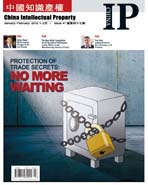The fourth detachment of the economic investigation team of Shanghai Municipal Public Security Office is a detachment which is mainly responsible for combating IP crimes and crimes of disorderly market conduct. According to Wang Jian, Lieutenant of the detachment, till August 2011, Shanghai has altogether investigated and prosecuted more than 600 IP crime cases in the national operation "Drawing Sword" for quieting down IP crimes since October, 2010. However, among these cases, only 3% involved trade secrets.
“In the sense of traditional investigation, trade secret cases have almost nothing special about them. Their investigations are even simpler because the parties in these cases, especially the perpetrator being reported, are very clear. Only the cases in which there are no reported perpetrators tend to be complicated,” said Wang Jian.
“However, in practice, there are usually many unexpected twists and turns to which the enterprises should pay special attention.”
According to his introduction, in the investigation of trade secret crimes, the public security organs must consider the following three points as a fixed procedure: (1) determine the trade secret or secrets at issue; (2) establish a channel and method to appropriate the trade secret by the person being reported; (3) determine the amount of unjust enrichment.
Just as with judicial determination, to determine a trade secret is the first problem to be solved by public security organs. “This is the first problem, as well as a very controversial one. Only when this problem is solved or the burden of proof is carried can we move on, set up a case, and use further investigation measures and means,” Wang Jian said. A complainant proves his case of establishing a trade secret crime, in reality, by independent evaluation. “When we receive the initial tips, the first thing for us to do is to verify whether the case includes an independent evaluation, which is a prerequisite. We can’t, however, rely solely on statements made by the proprietor or the complainant. This is the first thing the enterprises should pay attention to,” explained Wang Jian. “However, these independent evaluation results cannot be seen as necessarily the most conclusive evidence, either.”
In fact, after an evaluation agency provides a report claiming that certain technical information is a trade secret, if the accused asserts his rights and arguments, the police will ask another evaluation agency with the same qualifications to authenticate the information again.
However, the result usually contradicts the previous one.
“Such cases happen all the time. How to balance and determine the two contradictory results under the same technique and how to present evidence and control the situation are great difficulties for us. In the investigation, we have to obtain sufficient supporting evidence which can also determine the trade secrets, such as whether the enterprise has taken strict security measures,” said Wang.
Once a trade secret case is filed, the main problem to be investigated and solved by the public security organs is the channel and method to obtain the trade secret by the person being reported. “During this process, we need the reporting entity to provide sufficient evidence for both judgment and decision.” Wang Jian further explained that if an enterprise has taken security measures and has a series of procedure and steps arranged for protection of the technique and the secret, all these will be very important for obtaining the evidence necessary before authorities can accept and prosecute a trade secret infringement case.
According to Article 219 of the Criminal Law, the act of illegally obtaining trade secrets means “to obtain trade secrets of a person who enjoys the right by stealing, luring, force or any other improper means.” Only when the proof for the improper means of the actor to infringe upon the trade secret is obtained can a case be further investigated. “In the traditional decision process for the cases, stealing, luring and force are easier to determine and cognize. But we usually meet many obstacles during the process of evidence obtaining investigation,” Wang said, “The system process design of many enterprises cannot be restored, which means the operations in the system can’t be restored into the form of proofs. If we only depend on the enquiry and the testimony in such cases, the decision still has great uncertainty.”
As to the third point—determination of the amount of unjust enrichment, though there are some articles in the law, there are still many obstacles in practical situations. Therefore, the amount of loss is ultimately decided by third party certifying agencies in actual operations.
One of the constitutive components of trade secret infringement is that the infringing act has caused great loss upon the obligee. In judicial interpretation, the definition for “great loss” is a two part test: first, the amount of direct economic loss is over 500,000 yuan and second, there are other serious losses on the part of the obligee. In judicial practice, all the trade secret infringement cases are using 500,000 yuan as a constitutive component for investigating the criminal responsibility of the infringer. Similarly, the filing standard set by the public security organs in many regions is also 500,000 yuan. The legal field has been questioning about whether such a standard is too high for a long time. As a contrast, it is known that the standard in Shanghai is more reasonable as its system does not require the threshold of 500,000 yuan.
“Among the cases we have dealt with, in every case where the reporter does file the case due to insufficient loss of the obligee this amount is claimed, since they are aware the case will not be received otherwise.” Wang Jian emphasized, “The most controversial thing is not the threshold of the amount of loss, but the determination of the trade secret, which must be verified by independent agencies with appraisal qualifications.”
(Translated by Snow Li)




